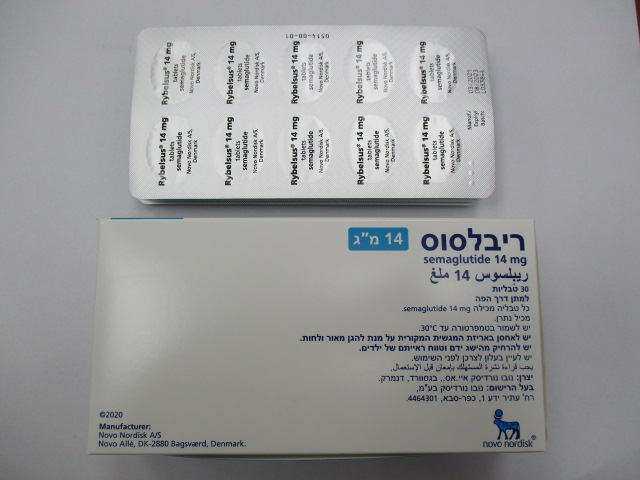Quest for the right Drug

ריבלסוס 14 מ"ג RYBELSUS 14 MG (SEMAGLUTIDE)
תרופה במרשם
תרופה בסל
נרקוטיקה
ציטוטוקסיקה
צורת מתן:
פומי : PER OS
צורת מינון:
טבליה : TABLETS
עלון לרופא
מינוניםPosology התוויות
Indications תופעות לוואי
Adverse reactions התוויות נגד
Contraindications אינטראקציות
Interactions מינון יתר
Overdose הריון/הנקה
Pregnancy & Lactation אוכלוסיות מיוחדות
Special populations תכונות פרמקולוגיות
Pharmacological properties מידע רוקחי
Pharmaceutical particulars אזהרת שימוש
Special Warning עלון לרופא
Physicians Leaflet
Adverse reactions : תופעות לוואי
4.8 Undesirable effects Summary of the safety profile In 10 phase 3a trials, 5,707 patients were exposed to semaglutide alone or in combination with other glucose-lowering medicinal products. The duration of the treatment ranged from 26 weeks to 78 weeks. The most frequently reported adverse reactions in clinical trials were gastrointestinal disorders, including nausea (very common), diarrhoea (very common) and vomiting (common). Tabulated list of adverse reactions Table 1 lists adverse reactions identified in phase 3 trials (further described in section 5.1) and post marketing reports in patients with type 2 diabetes mellitus. The frequencies of the adverse reactions (except diabetic retinopathy complications, see footnote in Table 1) are based on a pool of the phase 3a trials excluding the cardiovascular outcomes trial. The reactions are listed below by system organ class and absolute frequency. Frequencies are defined as: very common: (≥1/10); common: (≥1/100 to <1/10); uncommon: (≥1/1,000 to <1/100); rare: (≥1/10,000 to <1/1,000); very rare: (<1/10,000) and not known (cannot be estimated from the available data). Within each frequency grouping, adverse reactions are presented in order of decreasing seriousness. Table 1 Frequency of adverse reactions of oral semaglutide MedDRA Very common Common Uncommon Rare Not Known system organ class Immune system Hypersensitivityc Anaphylactic disorders reaction Metabolism Hypoglycaemia Hypoglycaemia and nutrition when used with when used with disorders insulin or other oral sulfonylureaa antidiabetic productsa Decreased appetite Eye disorders Diabetic retinopathy complicationsb Cardiac Increased heart disorders rate Gastrointestinal Nausea Vomiting Eructation Acute Intestinal disorders Diarrhoea Abdominal Delayed gastric pancreatitis obstructiond pain emptying Abdominal distension Constipation Dyspepsia Gastritis Gastro- oesophageal reflux disease Flatulence Hepatobiliary Cholelithiasis disorders General Fatigue disorders and administration site conditions Investigations Increased Weight lipase decreased Increased amylase Nervous system Dizziness Dysgeusia disorders a) Hypoglycaemia defined as blood glucose <3.0 mmol/L or <54 mg/dL. b) Diabetic retinopathy complications is a composite of retinal photocoagulation, treatment with intravitreal agents, vitreous haemorrhage and diabetes-related blindness (uncommon). Frequency is based on the cardiovascular outcomes trial with s.c. semaglutide, but it cannot be excluded that the risk of diabetic retinopathy complications identified also applies to Rybelsus. c) Grouped term covering also adverse events related to hypersensitivity such as rash and urticaria. d) From post-marketing reports. Description of selected adverse reactions Hypoglycaemia Severe hypoglycaemia was primarily observed when semaglutide was used with a sulfonylurea (<0.1% of subjects, <0.001 events/patient year) or insulin (1.1% of subjects, 0.013 events/patient year). Few episodes (0.1% of subjects, 0.001 events/patient year) were observed with semaglutide in combination with oral antidiabetics other than sulfonylurea. Gastrointestinal adverse reactions Nausea occurred in 15%, diarrhoea in 10%, and vomiting in 7% of patients when treated with semaglutide. Most events were mild to moderate in severity and of short duration. The events led to treatment discontinuation in 4% of subjects. The events were most frequently reported during the first months on treatment. Acute pancreatitis confirmed by adjudication has been reported in phase 3a trials, semaglutide (<0.1%) and comparator (0.2%). In the cardiovascular outcomes trial the frequency of acute pancreatitis confirmed by adjudication was 0.1% for semaglutide and 0.2% for placebo (see section 4.4.) Diabetic retinopathy complications A 2-year clinical trial with s.c. semaglutide investigated 3,297 patients with type 2 diabetes, with high cardiovascular risk, long duration of diabetes and poorly controlled blood glucose. In this trial, adjudicated events of diabetic retinopathy complications occurred in more patients treated with s.c. semaglutide (3.0%) compared to placebo (1.8%). This was observed in insulin-treated patients with known diabetic retinopathy. The treatment difference appeared early and persisted throughout the trial. Systematic evaluation of diabetic retinopathy complication was only performed in the cardiovascular outcomes trial with s.c. semaglutide. In clinical trials with Rybelsus of up to 18 months duration involving 6,352 patients with type 2 diabetes, adverse events related to diabetic retinopathy were reported in similar proportions in subjects treated with semaglutide (4.2%) and comparators (3.8%). Immunogenicity Consistent with the potential immunogenic properties of medicinal products containing proteins or peptides, patients may develop antibodies following treatment with semaglutide. The proportion of subjects tested positive for anti-semaglutide antibodies at any time point after baseline was low (0.5%) and no subjects had neutralising anti-semaglutide antibodies or anti- semaglutide antibodies with neutralising effect on endogenous GLP-1 at end-of-trial. Heart rate increase Increased heart rate has been observed with GLP-1 receptor agonists. In the phase 3a trials, mean changes of 0 to 4 beats per minute (bpm) from a baseline of 69 to 76 were observed in patients treated with Rybelsus. Reporting of suspected adverse reactions Reporting suspected adverse reactions after authorisation of the medicinal product is important. It allows continued monitoring of the benefit/risk balance of the medicinal product. Any suspected adverse events should be reported to the Ministry of Health according to the National Regulation by using an online form: http://sideeffects.health.gov.il.

שימוש לפי פנקס קופ''ח כללית 1994
לא צוין
תאריך הכללה מקורי בסל
לא צוין
הגבלות
לא צוין
מידע נוסף
עלון מידע לצרכן
01.08.21 - עלון לצרכן אנגלית 01.08.21 - עלון לצרכן עברית 01.08.21 - עלון לצרכן ערבית 11.10.22 - עלון לצרכן אנגלית 18.09.22 - עלון לצרכן עברית 11.10.22 - עלון לצרכן ערבית 08.09.23 - עלון לצרכן אנגלית 07.09.23 - עלון לצרכן עברית 08.09.23 - עלון לצרכן ערבית 13.11.23 - עלון לצרכן עברית 23.01.24 - עלון לצרכן אנגלית 23.01.24 - עלון לצרכן ערבית 12.05.24 - עלון לצרכן עברית 20.05.24 - עלון לצרכן עברית 02.08.24 - עלון לצרכן עברית 16.08.24 - עלון לצרכן אנגלית 16.08.24 - עלון לצרכן ערבית 27.04.21 - החמרה לעלון 18.09.22 - החמרה לעלון 07.09.23 - החמרה לעלון 12.05.24 - החמרה לעלוןלתרופה במאגר משרד הבריאות
ריבלסוס 14 מ"ג